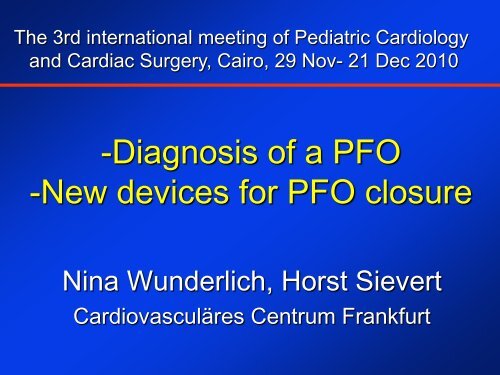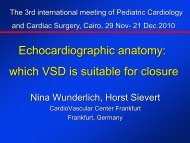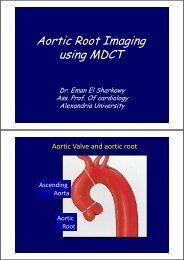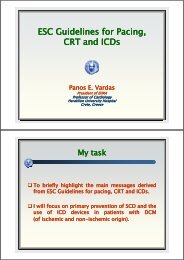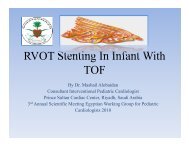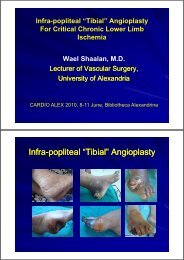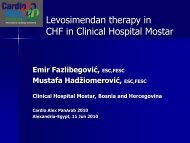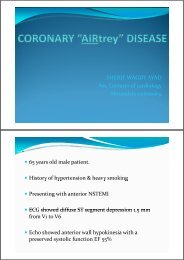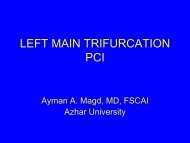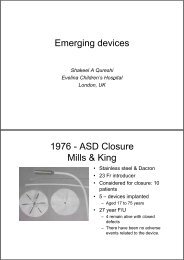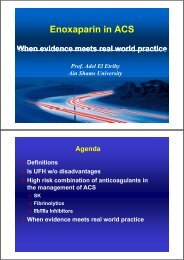-Diagnosis of a PFO -New devices for PFO closure
-Diagnosis of a PFO -New devices for PFO closure
-Diagnosis of a PFO -New devices for PFO closure
- No tags were found...
Create successful ePaper yourself
Turn your PDF publications into a flip-book with our unique Google optimized e-Paper software.
The 3rd international meeting <strong>of</strong> Pediatric Cardiologyand Cardiac Surgery, Cairo, 29 Nov- 21 Dec 2010-<strong>Diagnosis</strong> <strong>of</strong> a <strong>PFO</strong>-<strong>New</strong> <strong>devices</strong> <strong>for</strong> <strong>PFO</strong> <strong>closure</strong>Nina Wunderlich, Horst SievertCardiovasculäres Centrum Frankfurt
What isa <strong>PFO</strong>?• In utero, the<strong>for</strong>amen ovaleallows blood t<strong>of</strong>low from theright atrium tothe left,bypassing thelung• Usually it closesafter birth• But in ~25% <strong>of</strong>people it staysopen→ Patent Foramen Ovale
Role <strong>of</strong> Echo:How to diagnose a <strong>PFO</strong>• <strong>Diagnosis</strong>• Anatomy and Morphology• Shunt assessment• Associated atrial septumaneurysms and Eustachian Valve
Role <strong>of</strong> Echo:How to diagnose a <strong>PFO</strong>• <strong>Diagnosis</strong>• Anatomy and Morphology• Shunt assessment• Associated atrial septumaneurysms and Eustachian Valve
<strong>Diagnosis</strong> <strong>of</strong> <strong>PFO</strong>• TEE Transesophageal Echo- "Gold standard"• TTE Transthoracic Echo• TCD Transcranial Doppler
Echo ContrastAgitated salinewith microbubbleswhich do not survivepulmonary passageAgitated saline~60 micron (40-100)Agitated saline + blood~52 micron (24-75)
<strong>Diagnosis</strong> <strong>PFO</strong>TTE
So you can diagnose a <strong>PFO</strong>by transthoracic echo …… but you can not exclude it!No shunt on TTEdoes not mean that there is no <strong>PFO</strong>
Transcranial Doppler→ significant shunt: > 10 bubbles*Single HITSShowerCurtain(uncountable)*Consensus Conference <strong>of</strong> Venice - Jauss, Zanette ;Cerebrovasc Dis 2000; 10: 490-6
You can exclude a<strong>PFO</strong> by transcranialdoppler …… but you can notdiagnose it!
Why no diagnosis <strong>of</strong> <strong>PFO</strong>by transcranial doppler?• TCD is unable to locate the source <strong>of</strong>the right-to left shunt- <strong>PFO</strong> or ASD or intrapulmonary shunt?• However, TCD and TTE in combinationcan detect a <strong>PFO</strong> accurate and reliablein comparison to TEE ** Souteyrand,G et al. Eur J Echocardiography 2006; 7: 147- 154
… and intracardiac echo?• imaging is almost as good as TEE- sometimes better especially in the inferiorpart <strong>of</strong> the septum• usually more time consuming than TEE• more convenient <strong>for</strong> the patient• less convenient <strong>for</strong> the hospitaladministration- because it is much more expensive
The ideal <strong>PFO</strong> approach• For diagnosis‣ TCD <strong>for</strong> sreening‣ TTE (<strong>PFO</strong> or ASD?)• In the cath lab‣ TEE or ICE• To confirm the diagnosis• To exclude intrapulmonary shunts• To assess anatomical characteristics• To guide <strong>PFO</strong> <strong>closure</strong>
Intrapulmonary Shunting• Echo contrast appears late in the LA- But this may also happen in <strong>PFO</strong>s• More important is where in the LAthe contrast appears• Intrapulmonary shunting isconfirmed by echo contrast injectioninto the pulmonary artery
Intrapulmonary ShuntingContrast via femoral veinContrast via A. pulmonalis
Role <strong>of</strong> Echo:How to diagnose a <strong>PFO</strong>• <strong>Diagnosis</strong>• Anatomy and Morphology• Shunt assessment• Associated atrial septumaneurysms and Eustachian Valve
Anatomy and MorphologyWhich in<strong>for</strong>mation do we need?• Shape <strong>of</strong> defect• Size <strong>of</strong> defect• Rim size• Relation <strong>of</strong> device to other cardiacstructures during deployment- AV- Valves- Pulmonary veins- Coronary sinus
Right Atrium ViewLeft Atrium View
Typical <strong>PFO</strong>
Multifenestrated Septum2D TEE115˚ and 3D LA view
Rim assessment in 2DTEEsuperiorLAAV rim(inferior)posteriorLAaortic rim(anterior)IVC(caudal)LASVC rim(cranial)RALVRAAoRARV0 ˚ SAX 45 ˚ LAX 90 ˚
No anterior rim6 Month FU, Amplatzer Occluder
Role <strong>of</strong> Echo:How to diagnose a <strong>PFO</strong>• <strong>Diagnosis</strong>• Anatomy and Morphology• Shunt assessment• Associated atrial septumaneurysms and Eustachian Valve
Right to Left Shuntdepends upon• Size <strong>of</strong> <strong>PFO</strong>• Pressure RA - LA• Femoral or brachial echocontrast injection• Quality <strong>of</strong> Valsalva
Injection via cubital vein + Valsalva Injection via femoral vein +ValsalvaInjection via cubital vein + Valsalva:K no shunt!Injection V. fem + Valsalva
Shunt detection by echoworks but quantitativeassessment does not!!No need to countthe bubbles!
Sensitivity <strong>for</strong> Detection <strong>of</strong> <strong>PFO</strong>A descriptive study with contrast TEEJASE May 2008, 419 - 23
Role <strong>of</strong> Echo:How to diagnose a <strong>PFO</strong>• <strong>Diagnosis</strong>• Anatomy and Morphology• Shunt assessment• Associated atrial septumaneurysms and Eustachian Valve
Septal AneurysmBase diameterAneurysm( total excursion > 10mm)
<strong>PFO</strong> and septum aneurysmAneurysmLA<strong>PFO</strong>LARAAoRAAoExcursion to LAExcursion to RA
What's that?Large Eustachian Valve
Atypical LA Membrane16 mm Amplatzer ASD Occluder
How to close a<strong>PFO</strong>?
Implantation technique todayis straight <strong>for</strong>ward:• Local anesthesia• Transvenous 8-11 F sheath• 10,000 E Heparin• Multipurpose catheter left upper pulmonaryvein• Balloon sizing• Device implantation• < 30 min door to door• < 24 hours hospital stay
Most frequently used <strong>PFO</strong> <strong>devices</strong>AmplatzerCardioSEAL andCardioSEAL-STARflexHelex
BioSTAR (NMT)• CardioSEAL®framework• STARFlex® selfcenteringmechanism• Bioresorbable collagenmatrix- derived from thesubmucosal layer <strong>of</strong> theporcine small intestine(ICL)- Heparin coating
Solysafe ® (Carag)• Self-centering• Two foldable Polyesterpatches- attached to eight Phynox wires• Streched device fits into 10 Fintroducer• In the defect, wire-holdersare moved towards eachother• Clicking mechanism keepsthe wire-holders together
Premere <strong>PFO</strong> Closure DeviceSt. JudeeliveryystemLockRight AtrialAnchorCE-MarkUS: Clinical trialsTetherDelivery SystemRelease MechanismLeft AtrialAnchor• No fabric on theleft side• Flexible tetherholds anchorstogether• Variable distancebetween theanchors
<strong>New</strong> developments• <strong>New</strong> double- disc <strong>devices</strong>• In-tunnel <strong>devices</strong>• Suture based techniques
Nit-Occlud® <strong>PFO</strong>• Double umbrella occluderwith single-layer left atrial disc• Occluder is knitted from asingle Nitinol wire• Low pr<strong>of</strong>ile• No protrudingclamps• CE Mark since July 20103 sizes: 20 mm, 26 mm ,30 mm
The Spider TM <strong>PFO</strong>Occluder• Self-expandable, doubledisc device• Right atrial disc: ceramiccoated Nitinol wire mesh.• Left atrial disc: ePTFEpatch and ceramic coatedbraided nitinol anchors• Joint between the left atrialdisc allows free rotation <strong>for</strong>adaption to <strong>PFO</strong>morphology• Sizes 18mm, 25mm,30mm.
SeptRx <strong>PFO</strong> Closure Device• Closes the <strong>PFO</strong> tunnelfrom within• Nitinol frame andNitinol wire mesh• Small left and rightatrial anchors- Minimal material in leftand right atrium
CoherexDesigned to "Stent" the <strong>PFO</strong> tunnel
CoherexPig Model – 30 daysRA ViewLA View
Coherex• <strong>PFO</strong> <strong>closure</strong> from inside
Suture Closure <strong>of</strong> <strong>PFO</strong>• The suture <strong>closure</strong> <strong>of</strong> a <strong>PFO</strong> isintuitively attractive- No device left behind- No risk <strong>for</strong> device erosion- No risk <strong>of</strong> embolisation- Minimal risk <strong>of</strong> thrombosis- No need <strong>for</strong> aggressive antiplatelet regimen- No obstruction <strong>of</strong> atrial septum
The Sutura SuperStitch ® EL• Pr<strong>of</strong>ile: 12 Fr• Working length: 90 cm• Suture type:- Polypropolene 4-0• Knot type:- PolypropoleneArms and NeedlesCE marked
Take Home Messages• <strong>PFO</strong> Screening →TTE and TCD• Confirming <strong>of</strong> the diagnosis andintraprocedural Guidance → TEE or ICE• Follow-up → TTE, TCD and TEE• <strong>PFO</strong> <strong>closure</strong> is a straight<strong>for</strong>ward procedure• <strong>New</strong> <strong>devices</strong> are available or underdevelopment and may have someadvantages
Thank You
Pr<strong>of</strong>ile: 12 FrWorking length: 90 cmSuture type: Polypropylene 4-0Knot type: Polypropylene
The Sutura SuperStitch ® ELArms and Needles•Pr<strong>of</strong>ile: 12 Fr•Working length: 90 cm•Suture type: Polypropolene 4-0•Knot type: PolypropoleneCourtesy C. Ruiz
Morphology in TEESeptum secundumSeptumprimumSeptumsecundumLong axis view 109˚
Thrombi on <strong>devices</strong>Amplatzer Device- RA
ThrombusTTE after <strong>PFO</strong> <strong>closure</strong> with radi<strong>of</strong>requency
Thrombi on <strong>devices</strong>Amplatzer Device (LA)
The Spider TM <strong>PFO</strong>Occluder• 1) ceramic coat – lessthrombus <strong>for</strong>mation, fasterendothelialization andimproved biocompatibility.• 2) left atrial disc:only anchors and patch• joint between the left atrialdisc allows free rotation sooccluder can adapt to theunique morphology <strong>of</strong> the<strong>PFO</strong>, there<strong>for</strong>e no majorde<strong>for</strong>mation <strong>of</strong> the <strong>PFO</strong>tunnel.
Large <strong>PFO</strong> close to aortic root16mm Amplatzer Occluder
??Atypical RA Membrane
• TEE allows to identify patients at higherrisk requiring closer follow- up- significantly larger device than ASDdiameter- small pericardial effusion at 24 hr follow-up- de<strong>for</strong>mation <strong>of</strong> device at aortic root- high defect• A high quality transesophagealechocardiography helps to avoid most <strong>of</strong>the potential pitfalls and complicationsStandard equipment in the Cath Lab
Device Embolization LA24 mm Amplatzer Occluder- too small
Thank you!
SeptRx <strong>PFO</strong> Closure Device• Closes the <strong>PFO</strong> tunnelfrom within• Nitinol frame andNitinol wire mesh• Small left and rightatrial anchors- Minimal material in leftand right atriumRALA sideLARA side
The SeptRx- SystemOnly the left anchorsare liberatedHole device liberated
Echocardiographic AnatomyWhere to look <strong>for</strong> rims in TEE?• Aortic short- axis(~55-70˚)- Aortic rim- Posterior rim• Bicaval view (~ 90-120˚)- SVC and IVC rims• Four chamber view (~0˚)- Superior and AV valve rim
TEE alone is “not suitable” <strong>for</strong>quantification <strong>of</strong> RLS• <strong>PFO</strong> right to left shunting varies considerably• The amount <strong>of</strong> right to left shunt is a matter <strong>of</strong>expiratory pressure during the ValsalvaManeuver (1)• The magnitude <strong>of</strong> contrast shunting does notnecessarily correlate with the true anatomicalsize <strong>of</strong> the <strong>PFO</strong>(1) Devuyst G et al.Stroke 2004;35:859-63(2) Schuchlenz HW et al. AM J Med.2000; 109: 456-62/(3) Schuchlenz HW et al.Stroke 2002;33:293-6
Captured Starflex Occluder
What isa <strong>PFO</strong>?
Prolapse <strong>of</strong> a VelocimedOccluder
Residual Shunt…Why?• Occluder system type• Inappropriate device selection- Undersized device- Device malposition (partial)• Multifenestrated Septum primum
Potential Complications <strong>of</strong> device<strong>closure</strong> <strong>of</strong> septal defects• Occluder embolization/ Malpositioning• Atrial arrythmia• Thrombi on <strong>devices</strong>• Pericardial effusion• Interference with AV Valve function• Per<strong>for</strong>ation <strong>of</strong> atrial wall or aorta• Pulmonary vein obstruction (RUPV)• Stroke/TIA/peripheral Embolism• Frame fracture
Concordance <strong>of</strong> ICE and TEE24 <strong>devices</strong> in 23 patientsPre- release device position• All <strong>devices</strong> were deployed with a satisfactoryassessment <strong>of</strong> septal capture using ICE→ 99% concordance with TOE• No complications associated with ICE- Additional defects N= 2- Malpositions N= 5- PAPVD N= 1- Clot N= 1Mullen et al; JACC 2002
Do we need ICE?Acunav® catheter• 10 F 90 cm; 8F 100 cm• Miniaturized, 64 channel Multi Herz (5-10Mhz)transducer• Full color flow and Doppler capabilities• Quadridirectional steering• Inserted via seperate sheath into the femoral vein
Embolized occluder- distal Aorta
TCD vs TTEReference C.M. (i.v.) TTETCDSens/Spec % Sens/Spec %Nemec et al 1991 saline-air-blood 54/94 100/100Di Tullio et al 1993 aeroated saline 47/100 68/100Jauss et al 1994galactosemicrobubblesn.d. 93/100Anzola et al 1995 aeroated saline n.d. 90/100Droste et al 1999 aeroated saline - 95/75Droste et al 2000 aeroated saline - 100/100
And ICE?
ICE may be helpful inspecific casesTEEICE
Role <strong>of</strong> Echo in <strong>PFO</strong> <strong>closure</strong>• <strong>Diagnosis</strong>• Anatomy and Morphology• Shunt assessment• Associated atrial septumaneurysms and Eustachian Valve• Monitoring and guiding catheter<strong>closure</strong>• Follow-up after <strong>closure</strong>/ Occlusionrate monitoring
ImplantationTEE supports a correct device positioning anddetecting <strong>of</strong> acute complicationsAmplatzer OccluderTEE 150˚
Occluder slippingthrough defect in RACardioseal- Starflex Occluder
Rim assessmentPVsLALAA
Thrombus RAAfter balloon sizing
<strong>PFO</strong> and Atrial Septum Aneurysm) 25mm Helex (suboptimal) 2) 30mm Cardioseal (correct)
Role <strong>of</strong> Echo in <strong>PFO</strong> <strong>closure</strong>• <strong>Diagnosis</strong>• Anatomy and Morphology• Shunt assessment• Associated atrial septumaneurysms and Eustachian Valve• Monitoring and guiding catheter<strong>closure</strong>• Follow-up after <strong>closure</strong>/ occlusionrate monitoring
Follow up after <strong>closure</strong>What we are looking <strong>for</strong>?• Device position• Monitoring <strong>for</strong> potential complications- Pericardial effusion- Surrounding cardiac structures- Thrombi• Residual shunt
Residual Shunt• 90 % residual shunt immediatelyafter device implantation• 10 % after 6 months- Gaps between device and septum- Device not covered by tissue?- Additional defects
Residual shunt afterdevice implantation3-D Echo
Thrombi on <strong>devices</strong>ASDOS Device (RA)Starflex Occluder (LA +RA)
2247 Patients with atrial septal device <strong>closure</strong>,9 different <strong>devices</strong>,Incidence <strong>of</strong> thrombi evaluated using TEE (1+6 month)%(85% in the1 st month, 15% after 1 month)5432101.2%<strong>PFO</strong>0.9%ASDBaranowski et al; presented Mannheim 2007
Material• Nitinol framework• 2 Dacron patches• 2 Platinum markers• Polypropylene (Prolene®)• Idea and development:Dr. F. Freudenthal, Bolivia
What is different?• Occluder is knitted from a singleNitinol wire• Low pr<strong>of</strong>ile• No protruding clamps• Pre-mounted device
What is different?• Occluder is knitted from a singleNitinol wire• Low pr<strong>of</strong>ile• No protruding clamps• Pre-mounted device• Different release mechanism• Animal studies showed• Good adaption to septal wall• No protrusion into LA• Accelerated endothelialisationFreudenthal et al. 2004
Occlutech
How does a <strong>PFO</strong> differ from an ASD?ASD and <strong>PFO</strong> are different types <strong>of</strong> interatrial defects• The septumprimum <strong>for</strong>msfirst• It leaves awindow, theostiumsecundum• The septumsecundum <strong>for</strong>mslater, and usuallycovers theostiumsecundum
• If the septumsecundumfailes to coverthe ostiumsecundum,blood can flowin eitherdirection• This causes acontinuousshunt→ Atrial Septum Defect
Left AtriumSeptumPrimumSeptumSecundumSeptumSecundumRight Atrium
<strong>PFO</strong> TrackLeft AtriumSeptumSecundumSeptumSecundumRight Atrium
ilder<strong>Diagnosis</strong>:TTERestValsalva
CardioSEAL and CardioSEAL-STARflexTwo rectangular discseach consisting <strong>of</strong> four wire spring armsCovered with a polyester patchMicrospring system (CardioSEAL-STARflex)23, 28, 33, 40 mm
Amplatzer18, 25, 35 mmNitinol wire frame mesh with Dacron patches insideThe two discs are linked together by a short connecting waist
HelexTwo discs<strong>for</strong>med by one continuous Nitinolwire in the shape <strong>of</strong> a spiralePTFE patch is attached to the wire15-35 mm
30 Day Outcome <strong>of</strong> <strong>PFO</strong> Closure660 <strong>PFO</strong>-Patients, Randomized to 3 Devices5432%53.6101.40 00.9 01.4Amplatzer Helex CardioSEAL-STARflexAtrial fibrillation Thrombus Device embolisation0Am J Cardiol. 2008;101:1353-8
TEE 100 ˚ASD/ <strong>PFO</strong>/ ASA
Why is anatomy important?• For device selection• To decide which implantationtechnique- Through the <strong>PFO</strong> tunnel ortransseptal puncture?• To prevent complications
What does that mean?Injections, Injections,Injections….


